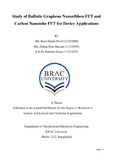| dc.contributor.advisor | Mominuzzaman, Dr. Sharif Mohammad | |
| dc.contributor.author | Pavel, Md. Reaz Haider | |
| dc.date.accessioned | 2016-01-26T15:06:10Z | |
| dc.date.available | 2016-01-26T15:06:10Z | |
| dc.date.copyright | 2015 | |
| dc.date.issued | 2015 | |
| dc.identifier.other | ID 11221050 | |
| dc.identifier.other | ID 11121055 | |
| dc.identifier.other | ID 11221033 | |
| dc.identifier.uri | http://hdl.handle.net/10361/4958 | |
| dc.description | This thesis report is submitted in partial fulfillment of the requirements for the degree of Bachelor of Science in Electrical and Electronic Engineering, 2015. | en_US |
| dc.description | Cataloged from PDF version of thesis report. | |
| dc.description | Includes bibliographical references (page 83-90). | |
| dc.description.abstract | The need for technological progression in the field of electronics has been persistently escalating. So
far silicon has been the most important fabrication material of preference for meeting the current
demands. However, silicon itself has few of its own limitations; Silicon based integrated circuits and
the scaling of silicon MOSFET design faces complications like tunneling effect, gate oxide thickness
effect etc. which has given the extensive perimeter for new materials with improved characteristics to
emerge.
In up to date periods, graphene and carbon nanotube have shown huge promise as materials that can
swap silicon-based materials in the future due to their outstanding electrical properties and other
characteristics. Simulation studies of graphene nanoribbon field-effect transistors (GNRFETs) and
carbon nanotube field-effect transistors (CNTFETs) at different contact temperatures are presented in
this thesis paper using models that have been methodically developed and are of increasing
thoroughness and versatility. This thesis covers the studies and modeling of graphene nanoribbon and
carbon nanotube, which includes band structures and current-voltage graphical plots. Also, an analysis
has been presented which shows the effect by varying contact temperatures for relative dielectric
constant and chirality on the device performance, in particular on the drain current.
The purpose of this paper is to the study behaviour of graphene nanoribbon transistors and carbon
nanotube transistors. The simulation is carried out using NanoTCAD ViDES program and the main
focus is on the changes in the I-V characteristic curves for transfer and output characteristics for
relative dielectric constant and chirality for different contact temperatures. The obtained results were
used to make a comparative analysis of the device performance of GNRFET and CNTFET. We
confirmed our work by contrasting of our results with other recognized academic papers published
under the same category. | en_US |
| dc.description.statementofresponsibility | Md. Reaz Haider Pavel | |
| dc.description.statementofresponsibility | Md. Zishan Ibne Hussain | |
| dc.description.statementofresponsibility | A.B.M. Rakibul Ahsan | |
| dc.format.extent | 155 pages | |
| dc.language.iso | en | en_US |
| dc.publisher | BRAC University | en_US |
| dc.rights | BRAC University Internship reports are protected by copyright. They may be viewed from this source for any purpose, but reproduction or distribution in any format is prohibited without written permission. | |
| dc.subject | Electrical and electronic engineering | en_US |
| dc.subject | FET | en_US |
| dc.title | Study of Ballistic Graphene Nanoribbon FET and Carbon Nanotube FET for device applications | en_US |
| dc.type | Thesis | en_US |
| dc.contributor.department | Department of Electrical and Electronic Engineering, BRAC University | |
| dc.description.degree | B. Electrical and Electronic Engineering | |

